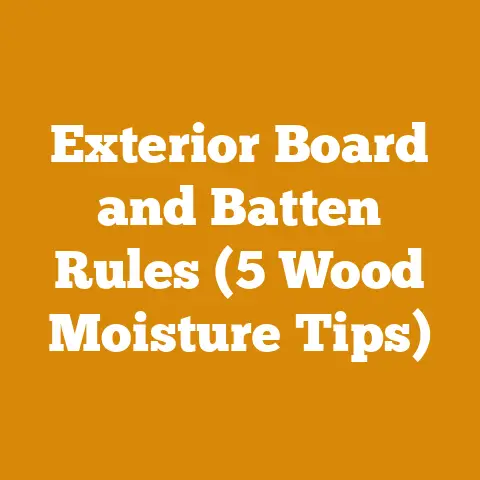Wood Burning Stove Temperature Guide (5 Pro Tips for Efficient Heating)
Wood Burning Stove Temperature Guide (5 Pro Tips for Efficient Heating)
You’re throwing money up the chimney if you’re not managing your wood-burning stove temperature correctly. It’s as simple as that. I’ve seen countless folks, from weekend warriors to seasoned homesteaders, load up their stoves, only to watch the heat – and their hard-earned cash – disappear in a puff of smoke. But don’t worry, it doesn’t have to be that way. Efficient wood burning is an art and a science, and understanding stove temperature is the key to unlocking its potential. I’ve spent years perfecting my own methods, and I’m here to share the secrets to maximizing heat output while minimizing wood consumption. Let’s dive in!
Mastering Your Wood Burning Stove: Temperature is King
Understanding and controlling the temperature of your wood-burning stove is paramount for efficient and safe heating. It’s not just about feeling warm; it’s about maximizing the energy you get from each log, minimizing creosote buildup (a significant fire hazard), and extending the lifespan of your stove. Think of it like tuning an engine – get it right, and it purrs along efficiently; get it wrong, and you’re headed for trouble.
Why Temperature Matters: Efficiency, Safety, and Longevity
Temperature directly impacts several crucial aspects of wood burning:
- Combustion Efficiency: Optimal combustion occurs within a specific temperature range. This range allows the wood to burn completely, extracting the maximum amount of heat. Incomplete combustion results in wasted fuel and increased emissions.
- Creosote Formation: Creosote is a flammable byproduct of incomplete combustion. It condenses in the chimney and can ignite, leading to a dangerous chimney fire. Maintaining proper stove temperatures helps prevent creosote buildup.
- Stove Lifespan: Overfiring a stove can cause it to warp, crack, or otherwise deteriorate prematurely. Conversely, consistently underfiring a stove can lead to excessive creosote buildup and corrosion.
- Fuel Consumption: When your stove is running efficiently, you’ll use less wood to achieve the desired level of heat. This saves you money and reduces your environmental impact.
5 Pro Tips for Efficient Heating
Here are five actionable tips to help you optimize your wood-burning stove temperature and achieve efficient heating:
1. Understand Your Stove’s Optimal Temperature Range
Definition: Every wood-burning stove has a specific temperature range where it operates most efficiently. This range is usually indicated in the owner’s manual or on a thermometer attached to the stove or flue pipe.
Why It’s Important: Operating within the recommended range ensures complete combustion, maximizes heat output, and minimizes creosote buildup.
How to Interpret It: The optimal temperature range is typically expressed in degrees Fahrenheit or Celsius. Pay attention to the location where the temperature is measured (stove surface, flue pipe, etc.) as this will influence the reading.
How It Relates to Other Metrics: This is the foundational metric. You can’t optimize other aspects of wood burning without knowing your stove’s optimal temperature range. It directly impacts fuel consumption, creosote formation, and heat output.
My Experience: I remember when I first got my stove, I ignored the manual. Big mistake! I was either choking the fire trying to conserve wood or blasting it so hot the stove glowed red. Once I learned the proper temperature range (250-500°F on the stove top), everything changed. I started using less wood and felt much safer.
Actionable Insight: Locate your stove’s recommended temperature range and familiarize yourself with it. Use a stove thermometer to monitor the temperature and make adjustments as needed.
2. Use a Stove Thermometer and Learn to Read It
Definition: A stove thermometer is a device used to measure the surface temperature of a wood-burning stove or the flue pipe.
Why It’s Important: It provides real-time feedback on the stove’s operating temperature, allowing you to make adjustments to maintain optimal performance.
How to Interpret It: Most stove thermometers have color-coded zones indicating optimal, overfiring, and underfiring temperatures. Pay attention to these zones and adjust your airflow accordingly.
How It Relates to Other Metrics: This is your primary tool for monitoring and controlling stove temperature. It helps you stay within the optimal range, reducing fuel consumption and creosote buildup.
My Experience: I’ve tried a few different types of thermometers – magnetic, probe, and even infrared. I prefer the magnetic ones that attach directly to the stove top. They’re easy to read and provide a quick snapshot of the temperature.
Actionable Insight: Invest in a reliable stove thermometer and install it in the recommended location. Regularly check the thermometer and adjust the airflow to maintain the temperature within the optimal range.
3. Control Airflow for Optimal Combustion
Definition: Airflow refers to the amount of air entering the stove, which directly affects the rate of combustion and the temperature of the fire.
Why It’s Important: Proper airflow ensures that the wood burns completely and efficiently. Too little air results in smoldering and creosote buildup, while too much air can cool the fire and waste fuel.
How to Interpret It: Most stoves have an air control lever or damper that regulates the amount of air entering the firebox. Adjust the lever to find the sweet spot where the fire burns brightly and steadily without excessive smoke.
How It Relates to Other Metrics: Airflow is the primary control mechanism for managing stove temperature. Adjusting the airflow directly impacts combustion efficiency, fuel consumption, and creosote formation.
My Experience: I’ve learned that the ideal airflow setting varies depending on the type of wood, the size of the fire, and the weather conditions. On cold, windy days, I need to increase the airflow slightly to maintain the desired temperature.
Actionable Insight: Experiment with your stove’s air control lever to find the optimal setting for different types of wood and weather conditions. Observe the flame characteristics and adjust the airflow until the fire burns cleanly and efficiently.
4. Burn Seasoned Wood for Higher Heat Output
Definition: Seasoned wood is wood that has been properly dried to reduce its moisture content.
Why It’s Important: Burning seasoned wood results in higher heat output, cleaner burning, and less creosote buildup. Wet wood wastes energy because it must first boil off the water before it can burn.
How to Interpret It: Seasoned wood typically has a moisture content of 20% or less. You can test the moisture content using a wood moisture meter. Seasoned wood will also be lighter in weight and have cracks in the end grain.
How It Relates to Other Metrics: Burning seasoned wood directly impacts combustion efficiency and fuel consumption. It also helps maintain optimal stove temperatures and reduces creosote formation.
My Experience: I once made the mistake of burning some wood that I thought was seasoned, but it turned out to be quite wet. The fire was sluggish, smoky, and produced very little heat. I learned my lesson and now always check the moisture content before burning any wood.
Actionable Insight: Only burn seasoned wood with a moisture content of 20% or less. Properly stack and dry your firewood for at least six months before burning it. Invest in a wood moisture meter to accurately measure the moisture content.
5. Maintain Proper Chimney Hygiene to Prevent Creosote Buildup
Definition: Chimney hygiene refers to the regular cleaning and inspection of your chimney to remove creosote and other debris.
Why It’s Important: Creosote buildup is a fire hazard and can significantly reduce the efficiency of your stove. A clean chimney allows for proper draft and ventilation, ensuring optimal combustion.
How to Interpret It: Inspect your chimney regularly for creosote buildup. If you see a significant accumulation of black, flaky, or tar-like deposits, it’s time to clean your chimney.
How It Relates to Other Metrics: Proper chimney hygiene is essential for maintaining safe and efficient wood burning. It prevents chimney fires and ensures that your stove operates at its optimal temperature.
My Experience: I’ve always been diligent about cleaning my chimney at least once a year. I even had a close call one year when I noticed a small chimney fire. It was a scary reminder of the importance of regular chimney maintenance.
Actionable Insight: Schedule regular chimney inspections and cleanings. Consider hiring a professional chimney sweep to ensure that your chimney is properly maintained. Burn hot fires periodically to help burn off creosote deposits.
Diving Deeper: Advanced Temperature Management
Once you’ve mastered the basics, you can delve into more advanced techniques for optimizing your wood-burning stove temperature.
Understanding Different Wood Types and Their Burning Characteristics
Different types of wood burn at different temperatures and rates. Hardwoods like oak, maple, and hickory burn hotter and longer than softwoods like pine, fir, and spruce. Understanding the burning characteristics of different wood types can help you fine-tune your stove temperature and fuel consumption.
Data Point: Oak typically has a BTU (British Thermal Unit) rating of around 28 million per cord, while pine has a BTU rating of around 20 million per cord. This means that oak produces significantly more heat per unit volume than pine.
Actionable Insight: Experiment with different types of wood to find the ones that work best for your stove and heating needs. Consider mixing hardwoods and softwoods to achieve a balance of heat output and burn time.
Using a Damper to Control Draft
A damper is a device installed in the flue pipe that restricts airflow and controls the draft of the chimney. Adjusting the damper can help you fine-tune the stove temperature and prevent overfiring.
Data Point: Closing the damper too much can lead to incomplete combustion and increased creosote buildup. Opening the damper too much can cause the fire to burn too quickly and waste fuel.
Actionable Insight: Experiment with the damper setting to find the optimal balance between heat output and fuel consumption. Start with the damper fully open and gradually close it until you achieve the desired temperature.
Monitoring Flue Gas Temperature
Flue gas temperature is the temperature of the gases exiting the stove and entering the chimney. Monitoring the flue gas temperature can provide valuable insights into the efficiency of your stove.
Data Point: Optimal flue gas temperatures typically range from 250°F to 400°F. Temperatures below 250°F can indicate incomplete combustion and increased creosote buildup. Temperatures above 400°F can indicate overfiring and wasted fuel.
Actionable Insight: Invest in a flue gas thermometer and monitor the temperature regularly. Adjust the airflow and damper settings to maintain the flue gas temperature within the optimal range.
Case Studies: Real-World Examples of Temperature Management
Let’s look at a couple of real-world examples of how temperature management can impact wood-burning stove performance:
Case Study 1: The Small Cabin
A small cabin owner struggled to heat their space efficiently with a wood-burning stove. They were using a lot of wood and still felt cold. After implementing the tips outlined above, including using a stove thermometer, burning seasoned wood, and adjusting airflow, they saw a significant improvement.
Before:
- Wood consumption: 1 cord per month
- Average stove temperature: 200°F
- Creosote buildup: High
After:
- Wood consumption: 0.5 cord per month
- Average stove temperature: 350°F
- Creosote buildup: Low
The owner was able to reduce their wood consumption by 50% and significantly decrease creosote buildup by simply managing the stove temperature more effectively.
Case Study 2: The Homestead Family
A homestead family relied on a wood-burning stove for primary heating. They were concerned about the safety of their stove and chimney. By implementing a regular chimney cleaning schedule and monitoring flue gas temperatures, they were able to prevent a chimney fire and ensure the safe operation of their stove.
Before:
- Chimney cleaning frequency: Once every two years
- Flue gas temperature monitoring: None
- Chimney fire risk: High
After:
- Chimney cleaning frequency: Once per year
- Flue gas temperature monitoring: Regular
- Chimney fire risk: Low
The family was able to significantly reduce their risk of a chimney fire by implementing a proactive approach to chimney maintenance and temperature monitoring.
Common Mistakes and How to Avoid Them
- Burning unseasoned wood: This is one of the most common mistakes. Always ensure your wood is properly seasoned before burning it.
- Overfilling the stove: Overfilling the stove can lead to incomplete combustion and increased creosote buildup. Load the stove with the appropriate amount of wood for the size of the firebox.
- Ignoring the stove thermometer: The stove thermometer is your primary tool for monitoring and controlling stove temperature. Don’t ignore it!
- Neglecting chimney maintenance: Regular chimney inspections and cleanings are essential for preventing chimney fires.
- Using the wrong type of wood: Different types of wood burn at different temperatures and rates. Use the appropriate type of wood for your stove and heating needs.
Troubleshooting Common Temperature Issues
- Stove won’t get hot enough: Check the airflow, wood moisture content, and chimney draft. Ensure the air control lever is open and the wood is properly seasoned.
- Stove is overheating: Reduce the airflow and close the damper slightly. Ensure the stove is not being overfilled with wood.
- Excessive creosote buildup: Burn hotter fires periodically and ensure the wood is properly seasoned. Schedule regular chimney cleanings.
- Smoky fire: Check the airflow and chimney draft. Ensure the air control lever is open and the chimney is not blocked.
The Future of Wood Burning: Technological Advancements
The wood-burning stove industry is constantly evolving, with new technologies being developed to improve efficiency, reduce emissions, and enhance safety. Some of these advancements include:
- Catalytic combustors: These devices reduce emissions by burning off pollutants in the flue gas.
- Non-catalytic stoves: These stoves use advanced combustion technologies to achieve high efficiency and low emissions without the use of a catalytic combustor.
- Smart stoves: These stoves use sensors and electronic controls to automatically adjust airflow and maintain optimal temperature.
- Pellet stoves: These stoves burn wood pellets, which are a renewable and sustainable fuel source.
The Environmental Impact of Wood Burning
Wood burning can have both positive and negative impacts on the environment. On the one hand, wood is a renewable resource that can be sustainably harvested. On the other hand, wood burning can produce emissions that contribute to air pollution.
To minimize the environmental impact of wood burning, it’s important to:
- Burn seasoned wood
- Use a modern, EPA-certified stove
- Maintain your stove and chimney properly
- Burn wood responsibly and avoid burning during air quality alerts
Conclusion: Mastering the Art of Efficient Wood Burning
Mastering the art of efficient wood burning is a journey that requires knowledge, patience, and practice. By understanding the principles of temperature management and implementing the tips outlined in this guide, you can maximize the heat output of your stove, minimize fuel consumption, and ensure the safe and sustainable operation of your wood-burning system. So, grab your thermometer, stack your wood, and get ready to experience the warmth and comfort of a perfectly burning fire. Remember, a well-managed wood-burning stove is not just a source of heat; it’s a connection to nature, a symbol of self-sufficiency, and a testament to the enduring power of fire.






